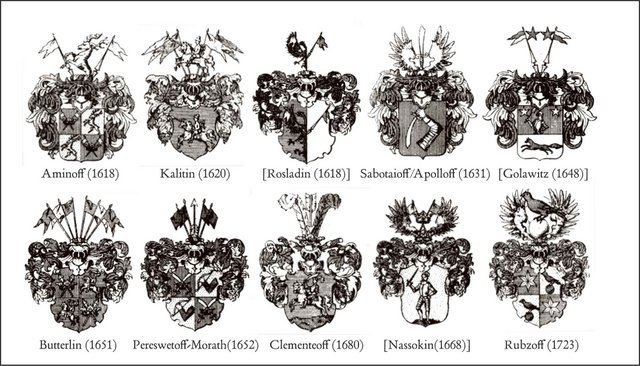 | ||
Bayors, Swedish: baijorer, ryss(e)baijorer [baˈjuːrəɹ], a Swedish transmogrification of Russian: бояринъ ‘boyar’, designating in the early modern era all Russian noblemen in general, and particularly a group of Russian noble families who had entered Swedish service in the late sixteenth–early seventeenth centuries and were incorporated into the Swedish nobility. Of these, the most notable were the families
which were all immatriculated (‘introduced’) at the Swedish House of Nobility (for their immatriculation numbers, see the List of Swedish noble families). In 1818, those families resident east of the Bothnian were similarly immatriculated at the Finnish House of Nobility, then in the Russian Grand Duchy of Finland (compare the List of Finnish noble families). The coats-of-arms granted by the kings of Sweden almost invariably allude to military prowess and tend to include weaponry which was regarded as 'Muscovite' (sabres, bows and arrows, maces; sometimes ‘tamed’ or ‘Swedicised’ by the crown within which they are crossed), mounted warriors and ‘northern’ animals. Of particular importance as a model, was the coat-of-arms of the Aminoffs.
During the seventeenth century, most of the bayor families were closely associated with the province of Ingria, where they were supposed to constitute a part of the ruling class that might be more acceptable to the Orthodox, to a large extent Russian, population than was the Lutheran Swedish and German nobility. Simultaneously, however, the bayors were expected to raise their sons as good Lutherans in order to retain an ‘eligibility’ to offices in the state and in the army. This fact led to nearly full integration into the Swedish nobility by the end of the seventeenth century, although at home, and especially among the women, Orthodoxy and syncreticism may still have been fairly widespread. The bayor families practiced endogamy to a large extent in the seventeenth century, which might have allowed Russian traditions to live on ‘at home’ but show increasingly less outwardly. This is to be contrasted with the state of affairs in c.1640 when almost all bayors would have regarded – and showed – themselves as Orthodox, as the elderly still did in the 1660s. Till the mid-century they frequently interceded for the protection of Orthodox institutions. Interestingly, the French Ingrian family Baro(h)n, several of whose members spoke Russian and were used as interpreters, was occasionally added to the group on a par with the ‘true’ bayors.
Especially in the early decades of Swedish Ingria, there were also, at a social level higher than the peasantry but below the bayors by far: the Russian townspeople of the city of Ivangorod and the townships of Jama, Caporie and Nöteborg, with some particularly well-off individuals (e.g. of the families Babin, Lebed, and Belous); the Orthodox clergy; the Russian so-called ‘half’ bayors, Swedish: half-baijorer; and a very small group of Tatar warriors. (The last two groups soon disappear from sight.)
A measure of their integration with Sweden may be had from a glance at the considerable number of officers from the bayor families who fought in the Swedish armies during the Great Northern War (1700–1721), mainly on the Baltic front (note, however, that the Nassokins and Baranoffs derived from an earlier, pre-Ingrian, layer of bayors and had for all practical purposes lost their Russian cultural identity, living, as they did, in Livonia and Finland; note also that the Swedish Rosladins, the Butterlins and the Zebotaioffs of the name were already extinct on the male line at the time). The officers were:
In several cases on the Baltic front, more than one bayor descendant might be found in the same detachment. Thus in the cavalry regiment of Colonel Carl Pereswetoff-Morath in Ingria we find the Captain Stephan Aminoff, the Lieutenant Carl Gustaf Rubzoff, and a Corporal Alexander Pereswetoff-Morath along with Major von Rohr, an Ingrian nobleman of German parentage. Apart from those enumerated, a great many sisters, wives and children were either killed, taken prisoner, enslaved, or managed to escape the Baltic provinces.
Among families which, for one reason or other, are not as regularly counted among the bayors we find the Homutoffs (Хомутовъ), the Carpofskis (Карповскiй), and the Luhmenoffs (Лугмѣновъ). The first two would doubtless have been among the most central ones had they not been extinguished on the male line before immatriculation. Several individual noblemen who had no issue or who were soon repatriated to Russia could be similarly referred to as ‘bayors’ in the seventeenth century.
At the present time, there seem to be living representatives only of the Aminoffs and the Pereswetoff-Moraths (and possibly, although apparently no longer in Scandinavia, the Kalitins).
